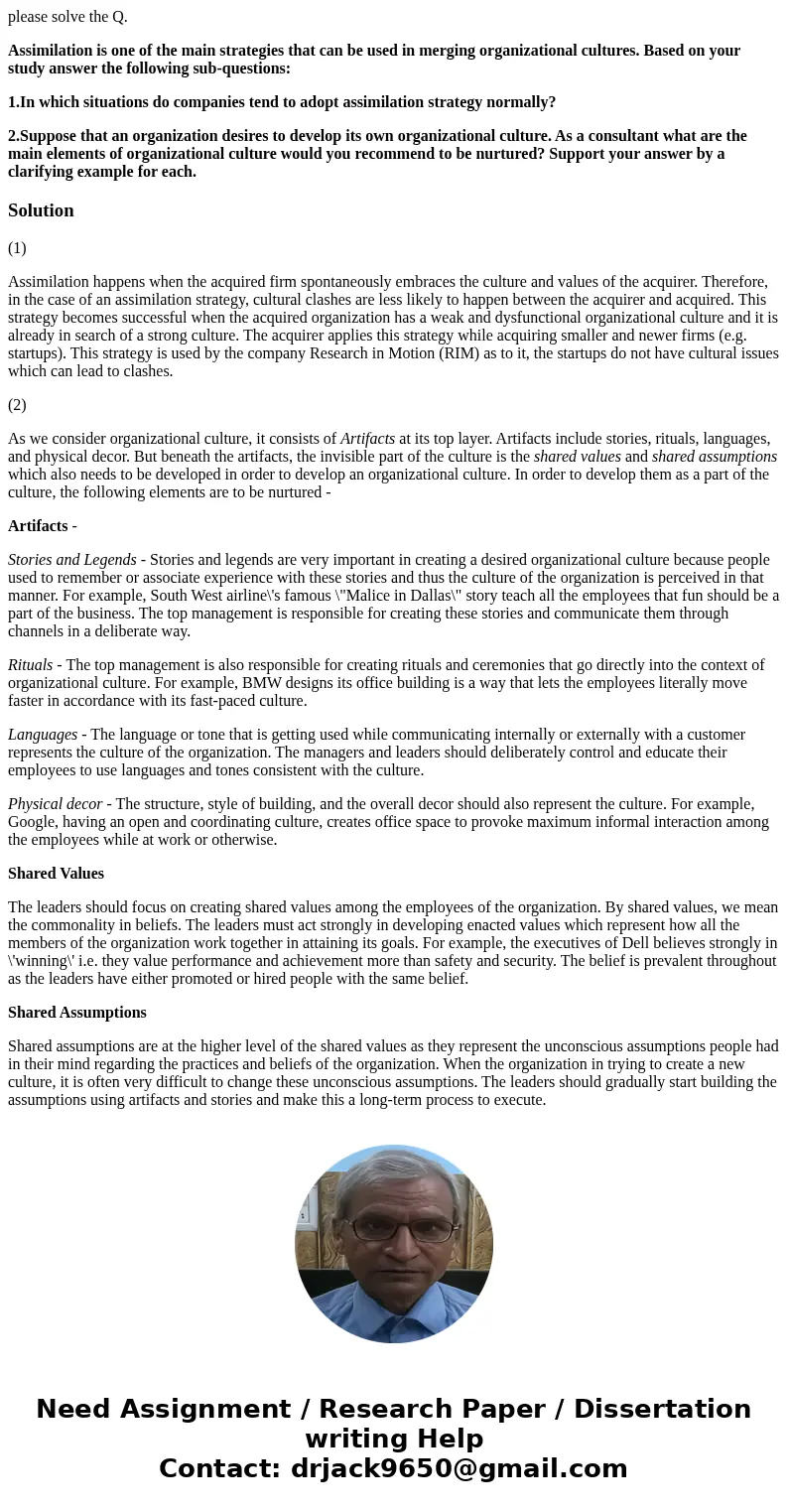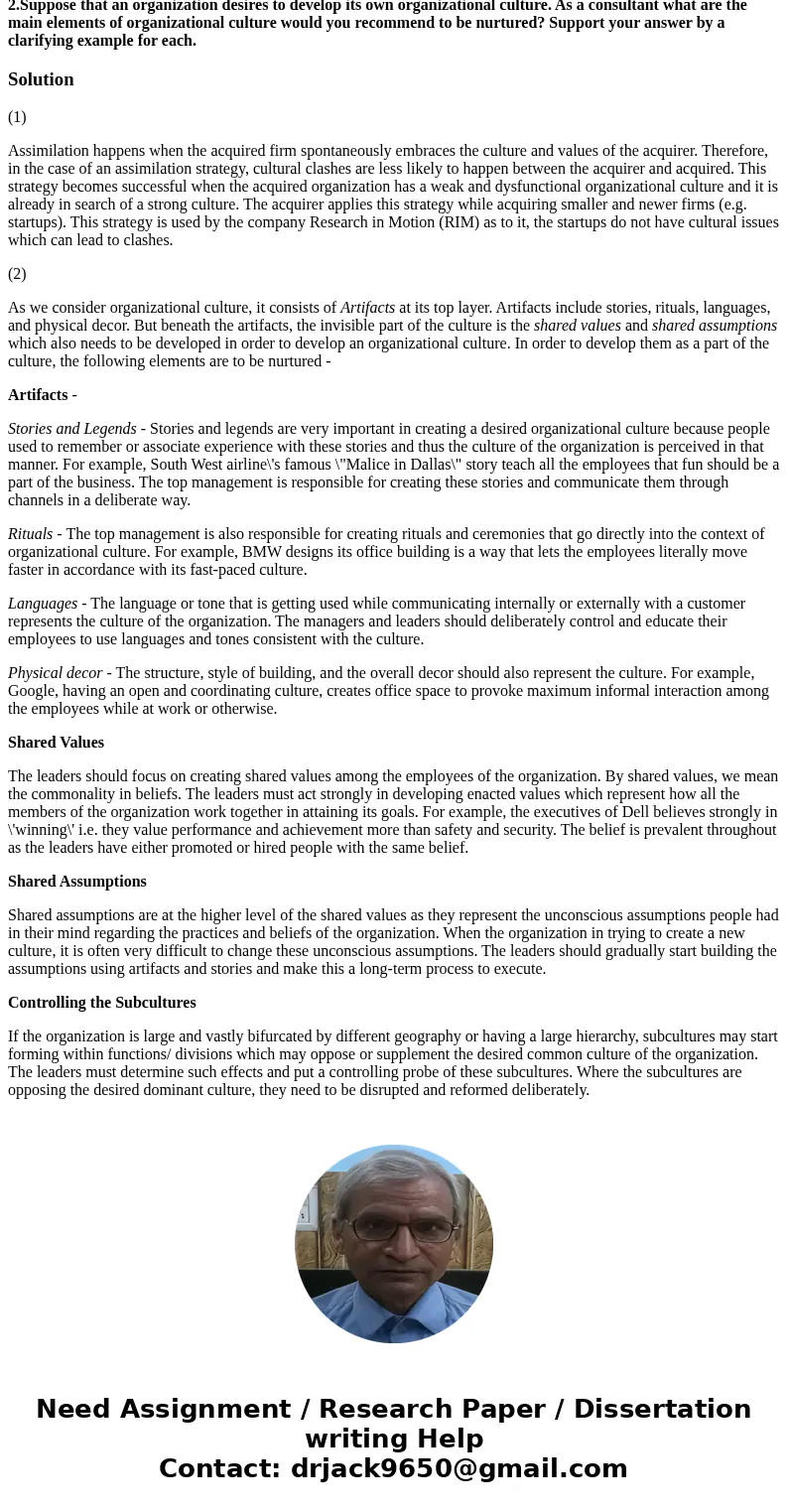please solve the Q Assimilation is one of the main strategie
please solve the Q.
Assimilation is one of the main strategies that can be used in merging organizational cultures. Based on your study answer the following sub-questions:
1.In which situations do companies tend to adopt assimilation strategy normally?
2.Suppose that an organization desires to develop its own organizational culture. As a consultant what are the main elements of organizational culture would you recommend to be nurtured? Support your answer by a clarifying example for each.
Solution
(1)
Assimilation happens when the acquired firm spontaneously embraces the culture and values of the acquirer. Therefore, in the case of an assimilation strategy, cultural clashes are less likely to happen between the acquirer and acquired. This strategy becomes successful when the acquired organization has a weak and dysfunctional organizational culture and it is already in search of a strong culture. The acquirer applies this strategy while acquiring smaller and newer firms (e.g. startups). This strategy is used by the company Research in Motion (RIM) as to it, the startups do not have cultural issues which can lead to clashes.
(2)
As we consider organizational culture, it consists of Artifacts at its top layer. Artifacts include stories, rituals, languages, and physical decor. But beneath the artifacts, the invisible part of the culture is the shared values and shared assumptions which also needs to be developed in order to develop an organizational culture. In order to develop them as a part of the culture, the following elements are to be nurtured -
Artifacts -
Stories and Legends - Stories and legends are very important in creating a desired organizational culture because people used to remember or associate experience with these stories and thus the culture of the organization is perceived in that manner. For example, South West airline\'s famous \"Malice in Dallas\" story teach all the employees that fun should be a part of the business. The top management is responsible for creating these stories and communicate them through channels in a deliberate way.
Rituals - The top management is also responsible for creating rituals and ceremonies that go directly into the context of organizational culture. For example, BMW designs its office building is a way that lets the employees literally move faster in accordance with its fast-paced culture.
Languages - The language or tone that is getting used while communicating internally or externally with a customer represents the culture of the organization. The managers and leaders should deliberately control and educate their employees to use languages and tones consistent with the culture.
Physical decor - The structure, style of building, and the overall decor should also represent the culture. For example, Google, having an open and coordinating culture, creates office space to provoke maximum informal interaction among the employees while at work or otherwise.
Shared Values
The leaders should focus on creating shared values among the employees of the organization. By shared values, we mean the commonality in beliefs. The leaders must act strongly in developing enacted values which represent how all the members of the organization work together in attaining its goals. For example, the executives of Dell believes strongly in \'winning\' i.e. they value performance and achievement more than safety and security. The belief is prevalent throughout as the leaders have either promoted or hired people with the same belief.
Shared Assumptions
Shared assumptions are at the higher level of the shared values as they represent the unconscious assumptions people had in their mind regarding the practices and beliefs of the organization. When the organization in trying to create a new culture, it is often very difficult to change these unconscious assumptions. The leaders should gradually start building the assumptions using artifacts and stories and make this a long-term process to execute.
Controlling the Subcultures
If the organization is large and vastly bifurcated by different geography or having a large hierarchy, subcultures may start forming within functions/ divisions which may oppose or supplement the desired common culture of the organization. The leaders must determine such effects and put a controlling probe of these subcultures. Where the subcultures are opposing the desired dominant culture, they need to be disrupted and reformed deliberately.


 Homework Sourse
Homework Sourse